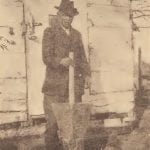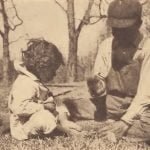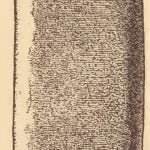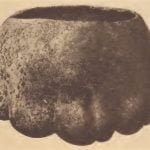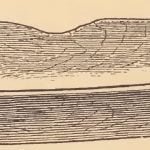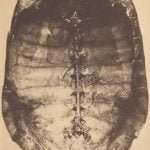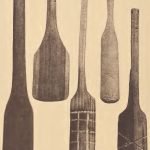A review of some agricultural practices of the modern Pamunkey shows but a few features of aboriginal survival. The corn now raised is the common yellow variety of commerce.
Among the several hundred inhabitants of the Pamunkey and Mattaponi villages there is not now a single log corn mortar in regular use. From some specimens previously collected, however, and from descriptions of those toward the bottom, with a disc like base (figs. S3-85). In modern times the wooden pestle with an iron wedge inserted in the end and held by an iron ring was employed. There is little evidence forth-coming to show that here the heavy stone pestle, so common in Pennsylvania and New England, was used. Only one implement exhibiting the form of the stone pestle has been found on the Pamunkey reservation, a smoothed stone of the pestle type, ten inches long, which was used by the wife of the chief for cracking corn, hitting the kernels upon a plank (fig. 87). She stated that her mother had employed it in a mortar. Aside from this tool the Virginia pestle seems to have been of the wooden form, though not of the long, heavy, double-ended type of the Iroquois, Delawares, and Cherokee.
Baskets for agricultural use are seldom made, although at Pamunkey, Ezekiel Langston constructs them for his own use in carrying fish. His material is white oak; his weave is the common twill. The rimming is plain, as is shown in fig. 89. At Mattaponi, however, the girls make baskets of honeysuckle stems and their work is neat (fig. 88). But regarding the history of the technique little can be said, except that it is suspiciously European in its details. We cannot be too sure that something like it did not exist in former times, as many references to baskets of different forms in early days are encountered. Among the Powhatan remnants the Rappahannock have best preserved the basket industry and this I have covered in a special report on that tribe. 1
The use of gourds as receptacles, so general among the southern tribes and referred to by the writers on early Virginia, has not been forgotten by the Indian descendants there today. They were and still are occasionally put into service for seed containers and water cups, and one was found employed as a soap dish (figs. 90, 91). The Pamunkey and Rappahannock do not plant gourd-seeds, but strew used not so long ago we know that the wooden mortar and pestle of the Powhatan area corresponded to those of the Nanticoke. Mortars were of gum-wood, about three feet high, some with straight sides, others hewed narrower them about on rich soil, leaving them to find a rooting themselves. They think it ”wrong” to sow them. Aboriginal habits survive in the employment of terrapin-shells (fig. 93) and fossil scallop-shells from the marl deposits (fig. 94) : articles remembered to have served generations ago and still at times used through sentimental feelings for the past, being kept as relics by some.
The corn, when gathered, is husked by the aid of the oak peg provided with a leather loop for the middle finger. Several specimens from Pamunkey and Mattaponi are illustrated, showing their conformity (figs. 97, 98). It may be noted that among the various surviving Indian communities of Virginia slight differences are observable in the proportions and leather grips of these tools, yet at Pamunkey and Mattaponi they are alike.
A number of agricultural superstitions and beliefs have been recorded among the half-dozen tribal units in Virginia and these I shall present separately under the topic of folklore.
Powhatan Agriculture Gallery
Citations:

